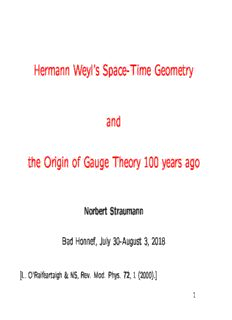
Hermann Weyl's Space-Time Geometry and the Origin of Gauge Theory 100 years ago PDF
Preview Hermann Weyl's Space-Time Geometry and the Origin of Gauge Theory 100 years ago
Hermann Weyl’s Space-Time Geometry and the Origin of Gauge Theory 100 years ago Norbert Straumann Bad Honnef, July 30-August 3, 2018 [L. O’Raifeartaigh & NS, Rev. Mod. Phys. 72, 1 (2000).] 1 Weyl’s Attempt to Unify Gravitation and Electromagnetism Weyl to Einstein (March 1918): “These days I succeeded, as I believe, to derive electricity and gravitation from a common source . . . .” 2 Weyl’s Generalization of Riemannian Geometry Weyl’s starting point was purely mathematical: “But in Riemannian geometry described above there is contained a last element of geometry “at a distance” (ferngeometrisches Element) — with no good reason, as far as I can see; it is due only to the accidental development of Riemannian geometry from Euclidean ge- ometry. The metric allows the two magnitudes of two vectors to be compared, not only at the same point, but at any arbitrarily separated points. A true infinitesimal geometry should, however, recognize only a principle for transferring the magnitude of a vector to an infinitesimally close point and then, on transfer to an arbitrary distant point, the inte- grability of the magnitude of a vector is no more to be expected than the integrability of its direction.” 3 Weyl’s physical speculation: “On the removal of this inconsistency there appears a geometry that, surprisingly, when applied to the world, explains not only the gravita- tional phenomena but also the electrical. According to the resultant theory both spring from the same source, indeed in general one cannot separate gravitation and electromagnetism in a unique manner. In this theory all physical quantities have a world geometrical meaning; the action appears from the beginning as a pure number. It leads to an essentially unique universal law; it even allows us to understand in a certain sense why the world is four-dimensional.” 4 Weyl-Geometry: Spacetime manifold M is equipped with a conformal structure [g]: • 2λ(x) g g g (x) = e g (x); 1 2 1 2 ∼ ⇔ same null cones. (Lengths can only be compared at one and the same world point.) M has (torsion-free) linear connection parallel transport, co- • → variant derivative . ∇ Linear connection respects conformal structure: • g = 2A g ( g = 2A g ), g [g], (1) α µν α µν ∇ − ⊗ ∇ − ∈ 1 where the map A : [g] Λ (M) satisfies → 2λ A(e g) = A(g) dλ. (2) − 5 A(g)is the gauge potential belonging to g, and (2) is what Weyl called a gauge transformation. In bundle theoretical language: A Weyl connection is a torsion-free connection of the conformal prin- ciple bundle (Weyl-bundle). [ (1), (2)] → Existence of covariant Weyl derivatives Generalize the well-known Koszul treatment of the Levi-Civita con- nection. In particular we generalize the Koszul formula to LC g( Y, X) = g( Y, X)+[ A(X)g(Y, Z)+A(Y )g(Z, X)+A(Z)g(X, Y )]. Z Z ∇ ∇ − Defines in terms of g and A. X ∇ Derivation. Explicitly a Weyl connection satisfies ( g)(Y, Z) = Xg(Y, Z) g( Y, Z) g(Y, Z) = 2A(X)g(Y, Z). X X X ∇ − ∇ − ∇ − 6 Since the torsion vanishes, i.e., Y X [X, Y ] = 0 X Y ∇ − ∇ − Xg(Y, Z) = g( X, Z) + g([X, Y ], Z) + g(Y, Z) + 2A(X)g(Y, Z). Y X ∇ ∇ Result follows after cyclic permutations. With routine calculations one verifies that the generalized Koszul formula defines a covariant derivative with vanishing torsion, and moreover it satisfies defining property. Local formula. Chose X = ∂ , Y = ∂ , , Z = ∂ of local coordinates: i j k 1 ∂ , ∂ = ( g + g + g ) + ( A g + A g + A g ). ∂ j k ji,k ik,j kj,i) i jk j ki k ij h∇ i i 2 − − Has to perform in the Christoffel symbols of the Levi-Civita con- nection the substitution g g 2A g . ij,k ij,k k ij → − 7 Non-integrable scale factor (gauge factor) Ratio of lengths in q and p (measured with g [g]) depends in ∈ general on the connecting path γ: l(q) = exp A l(p). − γ ! Z This equation holds for all g [g]! Transport of length path-independent ∈ ⇔ F = dA = 0 (F = ∂ A ∂ A = 0). µν µ ν ν µ − [ Weyl geometry and the Weyl-Cartan Theorem ?] 8 Consider G-structures on a manifolds M: Reductions of the bundle R of linear frames L(M) to a subgroup G GL(n; . For G = (n), a ⊂ O G-structure is equivalent to a Riemannian metric on M. The Weyl-Cartan Theorem states that for a closed subgroup G ⊂ R GL(n; , n 3 the following two conditions are equivalent: ≥ (1) G is the subgroup of all matrices which preserve a certain non- degenerate quadratic form of any signature. (2) For every n-dimensional manifold M and every reduced sub- bundle P of L(M) with group G, there is a unique torsion-free connection in P. Remark: Weyl-connections are not counter examples! 9 Change of calibration (gauge transformation) has absolute meaning. Passing to another calibration with metric ∇ ¯g, related to g by 2λ ¯g = e g, ¯ the potential A will also change to A: by definition ¯ ¯g = 2A ¯g; ∇ − ⊗ on the other hand: 2λ 2λ ¯g = (e g) = 2dλ ¯g + e g = 2dλ ¯g 2A ¯g. ∇ ∇ ⊗ ∇ ⊗ − ⊗ Thus ¯ ¯ A = A dλ (A = A ∂ λ). µ µ µ − − 10
Description: